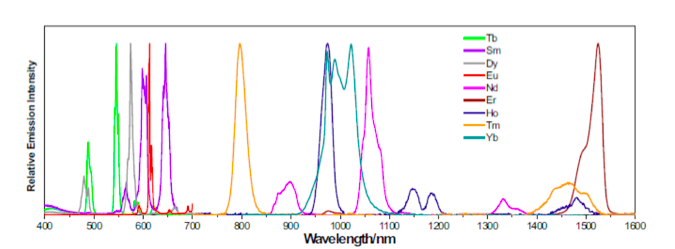
Lanthanide Sensitization in II-VI Semiconductor Materials
Group Members: Prasun Mukherjee, Daniel N. Lamont, Robin Sloan,
Collaborators: Chad M. Shade, Adrienne M. Yingling, Stéphane Petoud

The sharp luminescence bands of lanthanides (figure 1) and their insensitivity to the environment make them attractive candidates as imaging agents. Because the f-f transitions of lanthanides are Laporte forbidden, it is difficult to excite them and their emission strength is weak. Our group is developing novel strategies to overcome this limitation.

Figure 1. Normalized emission spectra of luminescent lanthanide complexes in solution.
One strategy that we are investigating uses the concept of an antenna that captures the radiation and transfers the energy to the lanthanides nonradiatively (figure 2). Early work showed that CdSe nanoparticles can be used as an antenna to sensitize Tb3+ luminescence. Current work in our group is exploring how to use ZnS nanoparticles to sensitize the luminescence of Tb3+ and other lanthanides. Our studies show that ZnS nanoparticles are better antenna for lanhanides than CdSe nanoparticles; moreover, the ingredients are less toxic, compared to the constituents in CdSe nanoparticles. Our studies are contributing to a better understanding of the mechanism of lanthanide luminescence sensitization in II-VI semiconductor materials.

Figure 2: Schematic diagram showing the concept of antenna effect.
References
(1) Chengelis, D. A.; Yingling, A. M.; Badger, P. D.; Shade, C. M.; Petoud, S. J. Am. Chem. Soc. 2005, 127, 16752-16753.